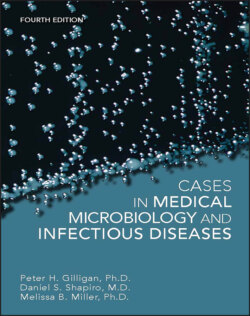Читать книгу Cases in Medical Microbiology and Infectious Diseases - Melissa B. Miller - Страница 12
Оглавление
TO THE STUDENT
This text was written for you. It is an attempt to help you better understand the clinical importance of the basic science concepts you learn either in your medical microbiology or infectious disease course or through your independent study. You may also find that this text is useful in reviewing for Part I of the National Board of Medical Examiners exam. It should be a good reference during your Infectious Disease rotations.
Below is a sample case, followed by a discussion of how you should approach a case to determine its likely etiology.
SAMPLE CASE
A 6-year-old child presented with a 24-hour history of fever, vomiting, and complaining of a sore throat. On physical examination, she had a temperature of 38.5°C, her tonsillar region appeared inflamed and was covered by an exudate, and she had several enlarged cervical lymph nodes. A throat culture plated on sheep blood agar grew many beta-hemolytic colonies. These colonies were small with a comparatively wide zone of hemolysis.
What is the likely etiologic agent of her infection?
The first thing that should be done is to determine what type of infection this child has. She tells you that she has a sore throat, “my throat hurts.” On physical examination, she has sign of an inflamed pharynx with exudate, which is consistent with her symptoms. (Do you know what an exudate is? If not, it’s time to consult the glossary in the back of this text.) She also has enlarged regional lymph nodes, which support your diagnosis of pharyngitis (sore throat).
What is the etiology of her infection? The obvious response is that she has a “strep throat,” but in reality there are many agents which can cause a clinical syndrome indistinguishable from that produced by group A streptococci, the etiologic agent of “strep throat.” For example, sore throats are much more frequently caused by viruses than streptococci. Other bacteria can cause pharyngitis as well, including Mycoplasma spp., various Corynebacterium spp., Arcanobacterium sp., and Neisseria gonorrhoeae. All of these organisms would be in the differential diagnosis, along with other perhaps more obscure causes of pharyngitis.
However, further laboratory information narrows the differential diagnosis considerably; small colonies that are surrounded by large zones of hemolysis are consistent with beta-hemolytic streptococci, specifically group A streptococci. On the basis of presenting signs and symptoms and the laboratory data, this child most likely has group A streptococcal pharyngitis.
Specific aids have been added to the book to assist you in solving the cases.
1 The book begins with “A Primer on the Laboratory Diagnosis of Infectious Diseases.” The purpose of this section is to explain the application and effectiveness of different diagnostic approaches used in the clinical microbiology laboratory. We recommend that you read this primer before beginning your study of the cases.
2 At the beginning of each book section is a brief introduction and a list of organisms. Only organisms on this list should be considered when solving the cases in that section. These lists have been organized on the basis of important characteristics of the organisms.
3 A table of normal values is available inside the front cover of this book. If you are unsure whether a specific laboratory or vital sign finding is abnormal, consult this table.
4 A glossary of medical terms which are frequently used in the cases is available at the end of the text. If you do not understand a specific medical term, consult the glossary. If the term is not there, you will have to consult a medical dictionary or other medical texts.
5 Figures demonstrating microscopic organism morphology are presented in many of the cases, as are key radiographic, laboratory, clinical, or pathologic findings. They provide important clues in helping you determine the etiology of the patient’s infection. Because many medical schools have abandoned “wet” labs where medical students get to do “hands-on” microbiology, we felt it was important to have a richly illustrated text.
A FINAL THOUGHT
The temptation for many will be to read the case and its accompanying questions and then go directly to reading the answers. You will derive more benefit from this text by working through the questions and subsequently reading the case discussion.
Have fun and good luck!
